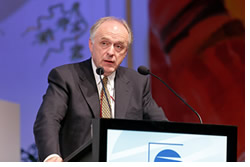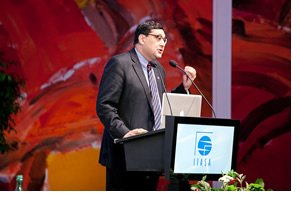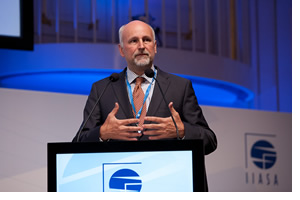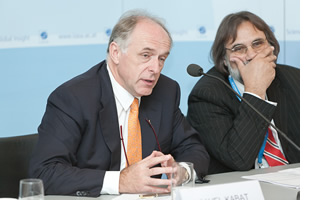December, 2012
News Clippings
Select news coverage from the IIASA 40th Anniversary Conference
Energiewirtschaftliche Tagesfragen Den globalen Wandel interdisziplinär erforschen – 40 Jahre IIASA
Nature Climate Change Water at a crossroads: Interview with IIASA Director & CEO Pavel Kabat
30 October, 2012
News Clippings
Select news coverage from the IIASA 40th Anniversary Conference
Voice of Russia IIASA "bridges" between East and West
Media Indonesia Menristek Tawarkan ABG untuk Solusi Global
Die Presse IIASA: Die Katastrophe als Chance
Heute.at Im Jahr 2100 gibt es 12 Milliarden Erdbewohner
Newsroom America Efforts To Mitigate Climate Change 'Must Target Energy Efficiency'
Armenia Today Угрожает ли исламская демография Европе?
26 October
Who does disaster hit the hardest?
As extreme events related to climate change become more common, Reinhard Mechler, a Senior Research Scholar in IIASA's Risk, Policy and Vulnerability Program, and other IIASA researchers are trying to define and understand the vulnerability of different populations around the world to those events. The study of risks arising from extreme events that are increasing in number, intensity, and duration has been driven by the changing climate itself, as opposed to the ability of different populations to withstand and then recover from a natural disaster. Mechler’s work is focused on understanding the “differential vulnerability” of different populations. Who is hit the hardest by an event, and why? How do different populations recover?
In some populations, money lenders can supply funds to help a farmer recover from a flood, he said, but the debt to the lender may preclude the farmer climbing out of poverty. In other cultures, where money lenders are not available, a family may sell its livestock or pull its children out of school to get the money needed to recover.
“Vulnerability is a fuzzy concept,” Mechler said, but a clearer understanding of how to prepare and recover from extreme events will likely make the impact of future natural disasters less disastrous.
26 October
Human capital vs. people
Describing people as “human capital” can seem cold, an indifferent view that treats individuals as mere products. But in reality, the term simply refers to the skills and abilities individuals develop primarily through education and experience.
In his introduction to the session of Assessing Education, Human Capital and Vulnerability this morning, William Butz, a senior research scholar with IIASA’s World Population Program, described human capital this way: “Human capital is something that is produced at a cost and yields a stream of benefits over time, including education — formal and informal — and health.” It sounds simple, but Butz noted that macroeconomists and environmental researchers have traditionally viewed every person as being the same, with little regard for individual characteristics.
IIASA is changing that. Butz said that researchers are now taking into account characteristics of human beings “that we know are responsible in the way policies work, differences in the way people react, the way people prepare for disaster and the way they react to it when (disaster) comes. And in particular we’re paying attention, to their education, cognitive function, and their attitudes and behavior toward risk.”
26 October, 2012
News Clippings
Select news coverage from the IIASA 40th Anniversary Conference
APA Trend zu mehr Energie, statt höherer Effizienz
Xinhua Net Power supply key to solving poverty: scientific conference
Salzburger Nachrichten Stromversorgung: Schlüssel zur Armutsbekämpfung
French.News.Cn Les chercheurs se penchent sur le manque de ressources énergétiques dans les pays en développement
Lums University Prof. Najam Speaks at IIASA’s 40th Anniversary Conference
26 October, 2012
Vision for IIASA
 What will IIASA look like in the coming years? At the end of yesterday’s sessions at the IIASA 40th Anniversary Conference, IIASA Director & CEO Prof. Pavel Kabat discussed his vision for IIASA as a global leader and hub for systems science. He noted that 40% of the current Institute budget goes to nexus research – that is, research that falls in between disciplines and programs. Another 20% of budget goes to specific projects that cross projects and programs, such as the new Global Water Futures: World Water Scenarios Project. What will IIASA look like in the coming years? At the end of yesterday’s sessions at the IIASA 40th Anniversary Conference, IIASA Director & CEO Prof. Pavel Kabat discussed his vision for IIASA as a global leader and hub for systems science. He noted that 40% of the current Institute budget goes to nexus research – that is, research that falls in between disciplines and programs. Another 20% of budget goes to specific projects that cross projects and programs, such as the new Global Water Futures: World Water Scenarios Project.
Kabat also emphasized IIASA’s hope to expand involvement with National Member Organizations (NMOs), providing more education opportunities around the world, as well as research that focuses on local and regional problems. The new Southern African YSSP program is one example of a new regional education program. Kabat also suggested the grounding of new regionally-focused research projects. He ended the session with an invitation. Kabat said, “Those who believe in co-benefits, in systems science: Come work with us.”
Session 8, Pavel Kabat: Watch the video
26 October
Convenient untruths about forest and climate
 “The best thing for climate is not to plant a tree,” said Center for International Forestry Research (CIFOR) Director General Frances Seymour in the final session yesterday of the IIASA 40th Anniversary Conference. Instead, she said, “the worst thing is to cut down a tree.” “The best thing for climate is not to plant a tree,” said Center for International Forestry Research (CIFOR) Director General Frances Seymour in the final session yesterday of the IIASA 40th Anniversary Conference. Instead, she said, “the worst thing is to cut down a tree.”
During her talk yesterday, Seymour listed a series of “convenient untruths” – common misconceptions about forests and deforestation. For example, she said, the idea that we must sacrifice forest land to improve food security is incorrect. She said that instead, forests are an important source of food as well as income. She said, “On average, forest-based income composes about 24% of household income, even more than from agricultural crops.” Another misconception, according to Seymour, is that poverty leads to deforestation. Instead, she said, deforestation is more often a cause of poverty than a result.
Seymour also noted that forests lie at the intersection between all of IIASA’s research problem areas: food & water, climate & energy, and poverty & equity.
Session 8, Frances Seymour: Watch the video
26 October, 2012
From Knowledge to Action
During a framing presentation yesterday during the session “Addressing the Challenges Concurrently – Science and Technology for Sustainable Development,” Harvard University researcher William Clark said, “The notion that science figures it out and then tells society what to do is wrong.” Instead, said Clark, the buzzwords should be “knowledge to action.” Knowledge, said Clark, includes not only science, but also local, experiential knowledge, such as the technical and environmental knowledge of a farmer. On the other side, said Clark, policy is just one part of the action needed to create change in the world. Clark said, “The challenge is for science to provide support for people in decision-making positions, not instructions.”
Session 7, William Clark: Watch the video
26 October, 2012
The many dimensions of poverty
 Poverty is not just about how much money one has. It also defines a basic quality of life, including access to infrastructure, healthcare and education as well as social safety nets and good governance. Focusing on just one aspect of poverty may lead to ineffective and inefficient solutions, said Pachauri yesterday at the IIASA 40th Anniversary conference. Her research shows that universal access to electricity has been achieved more rapidly in nations that have explicitly targeted this goal and have combined energy access with other poverty alleviation policies. By pursuing policy solutions that integrate energy access with other goals, Pachauri says, development goals will be met more easily. Poverty is not just about how much money one has. It also defines a basic quality of life, including access to infrastructure, healthcare and education as well as social safety nets and good governance. Focusing on just one aspect of poverty may lead to ineffective and inefficient solutions, said Pachauri yesterday at the IIASA 40th Anniversary conference. Her research shows that universal access to electricity has been achieved more rapidly in nations that have explicitly targeted this goal and have combined energy access with other poverty alleviation policies. By pursuing policy solutions that integrate energy access with other goals, Pachauri says, development goals will be met more easily.
Session 5, Shonali Pachauri: Watch the video
26 October, 2012
Fish, food, and the future
Seafood is the primary source of animal protein for more than one billion people. Yet there are many challenges in securing aquatic food resources: assessing the health and robustness of aquatic ecosystems is difficult, fish stocks are vulnerable to over-exploitation especially when they lie outside any one country's boundaries, harvesting fish can lead to unexpected evolutionary changes, and the responses of aquatic ecosystems to climate change remain to be understood.
IIASA’s Ulf Dieckmann yesterday provided an overview of how to integrate resource ecology with socio-economic assessments to provide better information for fishery managers and policymakers. For example, he said, a recent IIASA assessment of the population of Barents Sea capelin, the biggest fishery in Norway until it collapsed, showed that managing this fishery through size limits would be more effective than doing so through quotas, to preserve the fish population and to meet the needs of fishers and other stakeholders.
Session 3, Ulf Dieckmann: Watch the video
25 October, 2012
News Clippings
Select news coverage from the IIASA 40th Anniversary Conference.
ORF: 12 Milliarden Menschen bis 2100
Tempo (Indonesia): Menristek: PLTN Solusi Ketersediaan Listrik
Der Standard: Extrem mächtige Mitspieler kämpfen gegen den Wandel
APA: Energie-Umstieg brächte bedeutende Vorteile
Der Standard: Im Jahr 2100 leben 12 Milliarden Menschen auf der Erde
Der Standard: 40 Jahre Forschung an Lösungen globaler Probleme
UN News Center: Secretary-General, in Message, Says Research Performed by International Institute for Applied Systems Analysis Can Contribute to Achieving Key United Nations Goals
Pressemeldungen: Karlheinz Töchterle: IIASA steht für weltweit anerkannte Forschung in zentralen Zukunftsfeldern
Falter: Energiewende oder was?
More Press Clippings
25 October, 2012
Najam: Imagine the world as a single country
 Adil Najam, Vice Chancellor, Lahore University of Management Sciences in Pakistan changed the audience’s perspective yesterday afternoon, asking them to imagine they were on a rocket ship, looking at the Earth not as a planet, but as a single country. “You would see one billion people living on less than a dollar a day,” he said. You would see two billion more doing only slightly better. “You’d be looking at a poor country,” he said. You’d notice the huge divide between the very rich and everybody else, and you would see degraded forests, air that’s “not worth breathing,” a climate that is changing, as well as war and insecurity. You would conclude that the planet as a whole is poorly managed, he said, that it was unsafe, and that it was a third-world planet. Adil Najam, Vice Chancellor, Lahore University of Management Sciences in Pakistan changed the audience’s perspective yesterday afternoon, asking them to imagine they were on a rocket ship, looking at the Earth not as a planet, but as a single country. “You would see one billion people living on less than a dollar a day,” he said. You would see two billion more doing only slightly better. “You’d be looking at a poor country,” he said. You’d notice the huge divide between the very rich and everybody else, and you would see degraded forests, air that’s “not worth breathing,” a climate that is changing, as well as war and insecurity. You would conclude that the planet as a whole is poorly managed, he said, that it was unsafe, and that it was a third-world planet.
25 October, 2012
Schelling: The poor already bear the burden
Nobel Prize winner Thomas Schelling told IIASA’s 40th anniversary conference yesterday that millions of the world’s poor will see their incomes halved in the next few years due to climate change-related problems. Schelling asked delegates to imagine their plight, pointing out the extreme vulnerability to which the poorest people in poor countries are exposed through drought, food shortages, and rising food prices. No one is facing up to how urgent the situation is, Schelling said.
What is happening to the poor now, several discussants agreed, will be happening to mankind as a whole in 40-50 years unless urgent action is taken on climate change.
Thomas Schelling won the Nobel Prize in Economic Science in 2005 with Robert J. Aumann of the Hebrew University of Jerusalem for research on game theory. He worked with several IIASA programs between 1994 and 1999, and was active in the Young Scientists Summer Program.
Session 2, Thomas Schelling: Watch the video
25 October, 2012
Lutz: It's not just the number of heads
 Wolfgang Lutz, leader of IIASA’s World Population Program, said yesterday that one of the key drivers for global change is population – how many people are on the planet. While many view the growing population as a problem, Lutz said, “It is us, the people, who will have to come up with the solutions . . . because we are the human resources (that can) change our society.” Wolfgang Lutz, leader of IIASA’s World Population Program, said yesterday that one of the key drivers for global change is population – how many people are on the planet. While many view the growing population as a problem, Lutz said, “It is us, the people, who will have to come up with the solutions . . . because we are the human resources (that can) change our society.”
IIASA has developed probabilistic population projections that include age, sex and education levels for every country in the world. Education is important because it is tied to fertiliy: more highly educated women have fewer children. If education remains at current levels until 2050, with no new schools built, said Lutz, the world population could top 10 billion. If all nations invest heavily in education, the population number will likely be below 9 billion. Life expectancy is also increasing, with many people not only living longer than people in the past, but with their cognitive powers intact into old age. That is making demographic analysis more complex, but the take home message, Lutz said, is educate everybody and, “use our brains as hard as we can, as long as we can.”
Session 2, Wolfgang Lutz: Watch the video
25 October, 2012
Short-term decisions ignore long-term benefits
 Press Conference, 24 October: We are living in an age of great prosperity, but at the same time pushing planetary boundaries. During a press conference yesterday at the IIASA 40th Anniversary conference, IIASA Director and CEO Pavel Kabat discussed the key role of IIASA in providing broad systems science to support policy transformations that can make the world more sustainable and equitable. Kabat noted examples such as the IIASA-coordinated Global Energy Assessment, which recently appeared, as well as the Global Water Futures: World Water Scenarios Project, a new collaboration between IIASA and UN agencies. Press Conference, 24 October: We are living in an age of great prosperity, but at the same time pushing planetary boundaries. During a press conference yesterday at the IIASA 40th Anniversary conference, IIASA Director and CEO Pavel Kabat discussed the key role of IIASA in providing broad systems science to support policy transformations that can make the world more sustainable and equitable. Kabat noted examples such as the IIASA-coordinated Global Energy Assessment, which recently appeared, as well as the Global Water Futures: World Water Scenarios Project, a new collaboration between IIASA and UN agencies.
IIASA Deputy Director Nebojsa Nakicenovic noted that the Global Energy Assessment, developed with the participation of some 500 scientists, shows that the world could in fact provide the energy needed for a sustainable future – but only if nations follow the appropriate processes. Institutional change is needed, said Nakicenovic, but such change would require a large initial investment, which is inconsistent with our short-term decision-making approaches . This is especially true in view of the economic crises confronting many countries. While large transformations would not pay off immediately, said Nakicenovic, they would yield tangible financial benefits in the longer term.
Opening Session: Pavel Kabat: Watch the video
Session 1, Nebojsa Nakicenovic: Watch the video
25 October, 2012
Disaster as a communication catalyst
Speakers throughout the morning sessions on 24 October lamented that scientists find it difficult to convey information convincingly to policy makers and to the general public. Sadly, a disaster may present one of the rare occasions when an overriding need forces the communities to speak with one voice. During a press conference yesterday morning at the IIASA 40th Anniversary Conference, Idwan Suhardi, Indonesia’s Deputy Minister of Research and Technology, noted that the tsunami that devastated Indonesia in 2004 brought all stakeholders together. Policy makers depended upon scientists for guidance, and the scientific community had to convey information to the policy makers in understandable form. Together they then used the information to develop coherent guidance for the public on how to respond to the catastrophe.
When asked if a “tsunami equivalent” existed that would prompt similar synergy in the area of climate change, Thomas Schelling noted that a global temperature increase of 3 or 4 degrees could lead to melting of the West End Arctic Ice Sheet, which would raise global sea levels by some 6 meters. Such a rise would inundate half of Florida and such cities as Boston, London, and Copenhagen; the president of the United States would need a boat to get from the White House to Capitol Hill. When Schelling first heard of this possibility 30 years ago, scientists believed the ice sheet might melt within 70 years. Given the experience of the Netherlands in building dikes, Schelling sought guidance from Dutch colleagues on strategies for protecting Boston. To his surprise, the Dutch scientists suggested completely enclosing Boston Harbor with 10-meter dikes, evacuating the water, and thus gaining some 30 square miles of usable land. When Schelling commented that the Charles River might prevent such a solution, his colleagues noted that the population would have drained the river for drinking water.
This anecdote illustrates another theme that recurred throughout the morning sessions: that the inevitable uncertainties in science create skepticism among policy makers and the public, and prevent action. The 70-year horizon had stimulated some interest in countering global warming; however, research conducted in the following two decades indicated that the ice sheet would remain intact for 200–300 years. This removed any sense of urgency. Predictions in the last few years have changed again, and now indicate that the increase might occur within 50 years; this might again stimulate enough concern to prompt action.
Opening Session: Videos
25 October, 2012
Green money
Making money out of being green is nothing to be ashamed of, said delegates at IIASA’s 40th anniversary conference yesterday. If there’s a way of stripping CO2 out of the atmosphere and you can make money out of it, then this is the best incentive for helping the ailing planet planet. Katherine Richardson of the Sustainable Science Centre, University of Copenhagen told the conference not to apologise for making money from sustainable development issues. She heads the Danish Commission on Climate Change Policy.
Denmark's Parliament just passed the most ambitious green economy plan in the world: it will generate 35% of its energy from renewable energy by 2020 and 100% by 2050. The new move by Denmark would create new jobs and boost exports by 12%.The
Session 1, Katherine Richardson: Watch the video
24 October, 2012
Incentives, not fear
Director-General of UNIDO Kandeh Yumkella said this morning that the best way of communicating science to the public and to policymakers was by choosing appropriate narratives for political action. Al Gore had used fear as a narrative to get people to take climate change seriously. Yumkella said that a much better narrative would be the use of incentives.
This idea was taken up by Björn Stigson, former president of the World Business Council for Sustainable Development. The narrative we need, he said, was that science could create new opportunities, and governments could provide stimulus through subsidies.
Opening Session: Policy Support for Global Transitions: Watch the video
24 October, 2012
Sustainability sciences and the future
Neither policymakers nor the public fully realize how urgent it is to achieve sustainability, according to discussions at IIASA’s 40th anniversary conference. However, the direction of the strategies and pathways to sustainable development remain unclear.
UN Secretary-General Ban Ki-Moon has called for a set of sustainable development goals. In a video message, he said: “Let us develop a new generation of sustainable development goals to pick up where the MDGs leave off. Let us agree on the means to achieve them.”
Speakers throughout the day noted that we currently have no common framework for dealing with the “sustainability sciences,” making the integrating of scientific efforts toward sustainability impossible. These problems are exacerbated by the complexity of sustainability research at a time when integrating our scientific efforts is crucial.
Sustainable development is one of the crucial challenges of the 21st century world. The idea of Sustainable Development Goals (SDGs) was put forward at Rio+20 by Colombia, Guatemala, and Peru, as a way of complementing the Millennium Development Goals (MDGs) or building on this process.
Ban Ki-Moon Video Address
24 October, 2012
President Fischer recalls IIASA founding
 President Heinz Fischer of Austria said today he was just a “young man in the Austrian parliament,” when the decision was taken to found a scientific institute in Austria as a détente mechanism in the midst of the Cold War. President Heinz Fischer of Austria said today he was just a “young man in the Austrian parliament,” when the decision was taken to found a scientific institute in Austria as a détente mechanism in the midst of the Cold War.
President Fischer, who was giving the keynote speech at the opening session of the IIASA Conference in the Hofburg Palace, Vienna, was recalling the full support from both East and West for IIASA in 1972. The collapse of Communism potentially meant difficulties for IIASA, the President remarked, but all the problems were successfully resolved and IIASA was now going through a period of advancement, success, and progress that would have been unthinkable 10 years ago.
Opening Session: Watch the video
22 October, 2012, 17:15
Join us on the Web
This week, researchers, policymakers, and industry leaders will convene in Vienna and Laxenburg for the IIASA 40th Anniversary Conference, Worlds Within Reach: From Science to Policy. How can science and policy come together to provide solutions to global problems? Conference participants will discuss the latest thinking on global issues like climate, food, water, and energy.
Even if you are not attending this year's conference, you don't have to miss out. You can watch sessions live online, get news updates via the Web site, and follow along on social media for up-to-the-minute information.
Livestreaming
The event will be streamed live via the Web site at http://conference2012.iiasa.ac.at/stream.html. Videos of sessions will be posted soon after the event.
Conference News
Find news and updates from the IIASA conference on the Web site at http://conference2012.iiasa.ac.at/news.html
Social Media
Follow @IIASAVienna or use the hashtag #IIASA2012.
You can also find updates and information on IIASA's Facebook and YouTube.
For more information, visit the 40th Anniversary Conference website.
More information
Press Statements
Contact
Katherine Leitzell
T: +43 2236 807 316
E: leitzell@iiasa.ac.at |